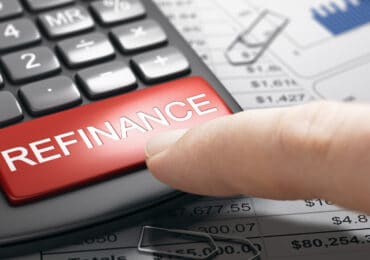When mortgage refinance rates are low, the desire to take advantage ASAP can be strong.

But many lenders make the mistake of positioning themselves to take on a high volume of new purchase clients instead of focusing on a more streamlined (and more profitable) refinance business.
For homeowners in need of liquidity or trying to get out of a bad rate, refinancing feels like being handed a set of tools with no instruction manual. Each option — whether a cash-out refinance, rate lock, or term adjustment — has its purpose, advantages, and timing.
But without knowing how these tools work or which are best suited to their needs, it’s easy to feel overwhelmed or worry about making the wrong choice. That’s where a good lender can position themselves as their community’s go-to refinance expert, generating a large volume of easy-to-close loans with better upside for the branch manager.
The Rate Lock Wrench: Securing a Lower Rate with Precision
Timing is everything, and locking in a favorable rate can be one of the most valuable moves.
Having a reliable rate-lock tool is like having a good wrench in your toolkit: it helps your clients “tighten up” their financial plans by locking in a specific rate for a set period, which gives them control and peace of mind, especially in a fluctuating market. While locking in a rate often requires a fee, it can be a worthwhile investment that secures your client savings.
The rate lock also helps you avoid delays, leaving your clients with a good impression, the first step in any repeat business relationship.
The question is, do you have access to the most competitive rates. You can use this helpful tool to check your rates against the most competitive broker rates on the market.
The Cash-Out Crowbar: Leveraging Home Equity for Financial Flexibility
For homeowners with substantial home equity, a cash-out refinance can unlock immediate financial resources. This refinancing option acts like a crowbar, allowing you to help your clients “pry open” their home’s value and free up cash for significant expenses. In a cash-out refinance, they replace their current mortgage with a larger loan, keeping the difference as cash in hand, which can be a financial game-changer, especially when used to pay down high-interest debt like credit cards or personal loans.
Your clients benefit from a single, lower-interest mortgage payment instead of multiple high-interest obligations, helping them manage debt and focus their finances on larger goals.

Alternatively, you could use cash-out refinances to help them make investments like home improvements, which can increase their home’s value, or to fund ventures like education or a small business. However, it’s important to consider the impact on their monthly payments. Since they’ll have a larger loan amount, payments may increase, so make sure you have access to loans with the flexibility to support their changing needs.
The No-Cost Hammer: Minimizing Upfront Expenses with a No-Cost Refinance
If upfront costs are a concern, a no-cost refinance may be the perfect solution. Much like a hammer in your toolkit, a no-cost refinance is straightforward and effective, allowing your clients to take advantage of mortgage refinance rates without the burden of upfront expenses. Here’s how it works: instead of paying closing costs out of pocket, you roll them into the client’s final loan principal or charge a slightly higher interest rate.
It’s especially beneficial for homeowners who want to lock in lower rates but don’t have immediate funds for closing costs. Or if they plan to refinance multiple times, it helps avoid the repeated expense of upfront payments. Keep in mind that they’ll pay a bit more over time than if they paid the costs upfront, since these costs get absorbed into the loan’s principal or interest rate. But the savings could still be worth more than if they do nothing, especially if they plan to stay in their home long-term.
The Term-Reduction Screwdriver: Shortening Loan Terms for Faster Financial Goals
If your clients want to build equity faster or pay off their mortgage sooner, add a term reduction loan to your toolkit. Just as a screwdriver helps adjust things for a snug fit, shortening their loan term can help them align with long-term goals like debt reduction, retirement, or increased equity. Instead of a 30-year mortgage, they might refinance to a 15- or 20-year term, which, while increasing monthly payments, offers substantial savings over the life of the loan.
One major benefit of a shorter term is that they’ll pay less interest overall, allowing them to build equity faster. It’s a particularly appealing move for those nearing retirement who want to eliminate mortgage debt before leaving the workforce. In addition, shorter-term loans often come with lower mortgage refinance rates, which can further reduce the cost of borrowing. Bottom line, if you have the flexible lending products to handle these needs, the payoff in the long term brings greater financial freedom to your clients.
The Adjustable-Rate Drill: Maximizing Flexibility in a Low-Rate Environment
Adjustable-rate mortgages (ARMs) are a unique tool in the refinancing toolkit, providing flexibility and potentially lower initial payments to your clients. Similar to a drill that adjusts to fit different needs, an ARM refinance can be beneficial in a low-rate environment, especially if they plan to sell or refinance again within a few years. An ARM typically starts with a lower, fixed mortgage refinance rate for a specific period — often three, five, or seven years — after which it adjusts based on the market. If they’re confident they’ll move or refinance before the adjustable period begins, the lower initial rate can help them save on payments in the short term, making it an effective tool for your clients who have a tighter purchase window. However, ARMs come with the risk of rate increases after the fixed period, so consider the timeline carefully.
The Rolling Refinancing Ratchet: Continuously Adjusting for Optimal Savings
Perhaps a lesser-known tool, rolling refinancing is like a ratchet that allows for continual adjustments, especially valuable in a steadily declining rate environment. By refinancing multiple times within a short period, homeowners secure progressively lower rates, optimizing savings as the market shifts. When you “ride the wave” of falling mortgage refinance rates, it consistently lowers your clients’ costs without waiting for rates to hit rock bottom.
For instance, if rates decrease gradually over time, they could refinance every six months or so, each time securing a better rate. Be sure to plan carefully, as repeated refinancing incurs closing costs and can impact their credit. But if executed strategically, rolling refinances can help you lock in significant savings for them over time. It’s a tool best suited for those committed to actively managing their mortgage and who have the financial flexibility to cover associated costs. In a falling-rate environment, it can be one of the most effective ways to continually improve their financial position.
Selecting the Right Tools for Low Mortgage Refinance Rates
Do you have a full refinance toolkit at your disposal? Or do you need to find a better institution or lending partner before refinance wave goes into full effect in 2025.
Start by assessing your current offerings: Can you reduce your clients’ monthly payments, helping them pay off debt, build equity faster, or maximize cash flow?